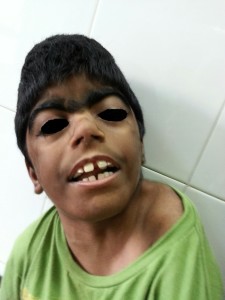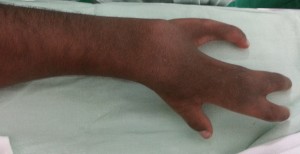Pallavi Gaur, MD1, Pravin Ubale, MD2, Namita Baldwa, MD3, Pinakin Gujjar, MD4
1Registrar; 2Associate Professor; 3Assistant Professor; 4Professor & HoD
Deprtment of Anesthesiology, Topiwala National Medical College & BYL Nair Charitable Hospital, Dr. A. L. Nair Road, Mumbai, Maharashtra 400008, (India)
Correspondence: Dr. Pravin Ubale, Anand Bhavan , B–16, Topiwala National Medical College & BYL Nair Charitable Hospital, Dr. A. L. Nair Road, Mumbai, Maharashtra 400008, (India); Tel: +93 22211472; E-mail: drpravinubale@gmail.com
ABSTRACT
Cornelia de Lange syndrome presents with various problems which include anatomical anomalies of face and extremities, cardiopulmonary and endocrine disorders, renal dysfunction, epileptic EEG waves, and mental retardation. Difficult airway and aspiration risk due to gastroesophageal reflux and poor esophageal motility are the main challenges in anesthesia management. The choice of anesthetic procedure must be carefully considered in view of these abnormalities. We report a 14years old male child who was a known case of Cornelia De Lange Syndrome for dental extraction with restorations under general anesthesia. The uneventful course of the anesthesia in the presented case was due to the thorough systemic evaluation and careful anesthetic strategy.
Key words: Cornelia de Lange syndrome; Difficult Intubation; Gastroesophageal reflux
Citation: Gaur P, Ubale P, Baldwa N, Gujjar P. Anesthetic management of a patient with Cornelia De Lange syndrome. Anaesth Pain & Intensive Care 2016;20(1):62-64.
INTRODUCTION
Management of syndromic patients with mental and growth retardation has always been challenging for anesthesiologists. One among the rare genetic disorders is Cornelia de Lange syndrome (CdLS). This syndrome is a constellation of congenital anomalies involving multiple systems of the body specifically presenting with craniofacial and limb deformities. It is also known as Brachmann de Lange syndrome, with reported incidence ranging between 1in 30000 to 40000.1,2 This genetic disorder is characterized by typical facies with bushy eyebrows meeting at midline, elongated philtrum, thin downturned lips, dental problems, short neck and systemic malformation involving cardiac, neurological, musculoskeletal, gastrointestinal and genitourinary defects.1,3,4 We present successful anesthetic experience in a child with CdLS posted for the management of multiple dental caries.
CASE REPORT
A 14 years male child, weighing 15 kg, who was a diagnosed case of CdLS, was planned for multiple dental extractions and restorations. Preoperative examination of child showed small face with microbrachycephaly, thick bushy arched eyebrows coinciding at midline, long eyelashes, depressed nasal bridge with anteverted nares, long philtrum, thin downturned upper lip, protruded and widely spaced central incisors, low set ears, micrognathia and short extended neck. On musculoskeletal examination short upper and lower limbs with syndactyly of 2nd and 3rd fingers with simian crease and contractures of elbow and knee joints was noted (Figure 1 & 2).

Figure 1: The child showing microbrachycephaly, thick bushy arched eyebrows, long eyelashes, depressed nasal bridge with anteverted nares, long philtrum, thin downturned upper lip, protruded and widely spaced central incisors, micrognathia and short extended neck

Figure 2: Syndactyly of 2nd and 3rd fingers with simian crease
Pectus excavatum with wide spaced nipples and prominent thoracic scoliosis was also noted. Genitourinary examination revealed undescended testis. Patient had severe growth and mental retardation with speech impediment. Hence airway examination could not be done. Patient had history of gastro esophageal reflux disease (GERD) in early childhood and was currently on treatment with tablet Lansoprazole 7.5 mg once a day.
Routine biochemical investigations were within normal limits. Chest X-ray AP/ Lateral view revealed decreased cervical and dorsal vertebrae heights, thoracic scoliosis, reduced intervertebral disc spaces and crowding of ribs. Echocardiography showed no abnormality. A high risk written well informed consent was taken and starvation confirmed on day of surgery. Difficult airway kit including variable sizes of facemasks, oral airways, nasopharyngeal airways, endotracheal tubes, Proseal® LMA and emergency cricothyroidotomy kit were kept ready. Peripheral intravenous access was secured in right forearm in the second attempt. The patient was premedicated for aspiration prophylaxis with pantaprazole (0.8 mg/kg) and ondansetron (0.08 mg/kg) intravenously. In addition, Inj glycopyrrolate 0.04 mg, inj midazolam 0.5 mg, inj fentanyl 20 µg was administered. Patient was planned for nasal intubation for dental extractions. Patient was induced with thiopentone sodium 50 mg slowly intravenously. Patient could not be adequately ventilated with facemask and required insertion of oropharyngeal airway. Subsequently inj atracurium 7.5 mg was given. On direct laryngoscopy Cormack-Lehane grade of 3 was observed. Cuffed endotracheal tube no. 5.0 was inserted through the nostril and negotiated through the cords with external laryngeal manipulation. Oropharyngeal throat packing was done. Anesthesia was maintained with O2, air and sevoflurane with intermittent doses of inj atracurium. Neuromuscular monitoring was done with peripheral nerve stimulator. Hemodynamic and other vital parameters were stable. For pain relief inj paracetamol 150 mg was given. The surgeon blocked the alveolar nerves. Total duration of surgery was two hours. Delayed recovery from general anesthesia was noted. Child was reversed with inj glycopyrrolate 1.2 mg, inj neostigmine 0.75 mg and extubated after regular respiration and return of adequate tone, power and reflexes. Patient was shifted to post anesthesia care unit (PACU) for monitoring.
DISCUSSION
Cornelia de Lange syndrome is a rare disorder, prenatal in onset characterized by facial dysmorphism, hirsutism, and musculoskeletal deformities with multiple system involvement. This syndrome is believed to occur secondary to hypoplasia of mesenchyme.5 Around 60% of CdLS cases accounts from mutation in NIPBL gene in chromosome 5 and SMC1A gene on inactivated X chromosome while around 5% cases have mutation in SMC3 in chromosome 10.4
Various concerns from anesthesia point of view include difficult intubation, aspiration risk, behavioral disturbances, recurrent respiratory infections with compromised lung functions due to severe scoliosis and other musculoskeletal abnormalities, difficult venous access and malignant hyperthermia. As the patient had mental retardation with behavioral changes, he would not cooperate for the procedure under local anesthesia. The patient being uncooperative, aggressive and labile, we faced difficulties in preoperative examination, pulmonary function testing, blood sampling, x-rays and intravenous cannulation.
The craniofacial features associated with difficult airway include microcephaly, micrognathia, wide spaced with prominent central incisors, macroglossia and short stiff extended neck.4–6 Awake fibreoptic intubation couldn’t be done in this patient due to severe mental retardation. Pre-anesthetic evaluation of such features and other cardiorespiratory parameters is utmost important. Thereby, anticipation of anesthetic implications posed by these features well before is most vital for better outcome of patient.
Our patient had history of GERD and hence aspiration prophylaxis was administered perioperatively.4 Severe scoliosis and pectus excavatum in our patient posed the danger of respiratory compromise and other postoperative pulmonary complications. Care was taken to prevent any form of respiratory infection by adequate nebulization and antibiotic cover. With the advancing age changes of musculoskeletal system becomes more severe leading to scoliosis, limb contractures like elbow and knee joints, pectus excavatum, radial head dislocations etc.4,6 Postoperative pulmonary complications are more common in such patients due to recurrent respiratory infections, irritable airways and more episodes of hypercapnia and hypoxia.4
We avoided Succinylcholine in our patient, because of the danger of precipitation of malignant hyperthermia being reported in some of the cases.2
We observed delayed recovery from anesthesia in spite of use of sevoflurane as inhalational agent and short acting atracurium as neuromuscular relaxant. Immaturity of musculoskeletal and neurological system could be proposed for this delayed recovery. Nitrous oxide should be avoided due to effect on pulmonary vascular resistance.4 Newer inhalational anesthetic agents like sevoflurane, desflurane and isoflurane are preferred for early recovery unlike halothane.4
Such patients are also at risk of convulsions and seizure disorders. Prophylaxis should be taken not to use any anesthetic agent which may precipitate convulsions like ketamine.7 Our patient did not present with such history but care was taken to prevent any episode of convulsion.
CONCLUSION
Anesthetic management of Cornelia de Lange syndrome is very challenging due to the multi-systemic nature of the disease. Successful management of such cases requires meticulous pre-anesthetic evaluation of risk factors and appropriate preparation for the same with vigilant postoperative monitoring.
Conflict of interest: None declared by the authors.
REFERENCES
- Sen A, Calapoglu AS, Sen H. Anesthetic Management of Cornelia de Lange Syndrome: A Case Report. Erciyes Tıp Dergisi/Erciyes Med J. 2015;37(1):43-44.
- Ozturk E, Bozkirli F OZ. Anesthetic management of a patient with cornelia de lange syndrome. Gazi Med J. 2000;11:175-177.
- Yalcin S, Aydoğan H, Karahan MA. Anesthetic management in Cornelia de Lange Syndrome. J Harran Univ Med Fac. 2013;10(1):46-47.
- Veronica Washington alan daVid K. Anesthetic management in a patient with Cornelia de Lange Syndrome. Middle East J Anaesthesiol. 2010;20(6):773-778.
- Papadimos TJ, Marco AP. Cornelia de Lange syndrome, hyperthermia and a difficult airway. Anaesthesia. 2003;58(9):924-925. [PubMed]
- Torres MD, Calvo E, Fernández Esplá F, Gilsanz F. Anesthetic management of an adult patient with Cornelia de Lange Syndrome. Minerva Anestesiol. 2010;76(3):229-231. [PubMed]
- Takeshita T, Akita S, Kawahara M. Anesthetic management of a patient with Cornelia De Lange syndrome. Anesth Prog. 34(2):63-65. [PubMed] [Free full text]




 Facebook
Facebook Twitter
Twitter GooglePlus
GooglePlus Youtube
Youtube